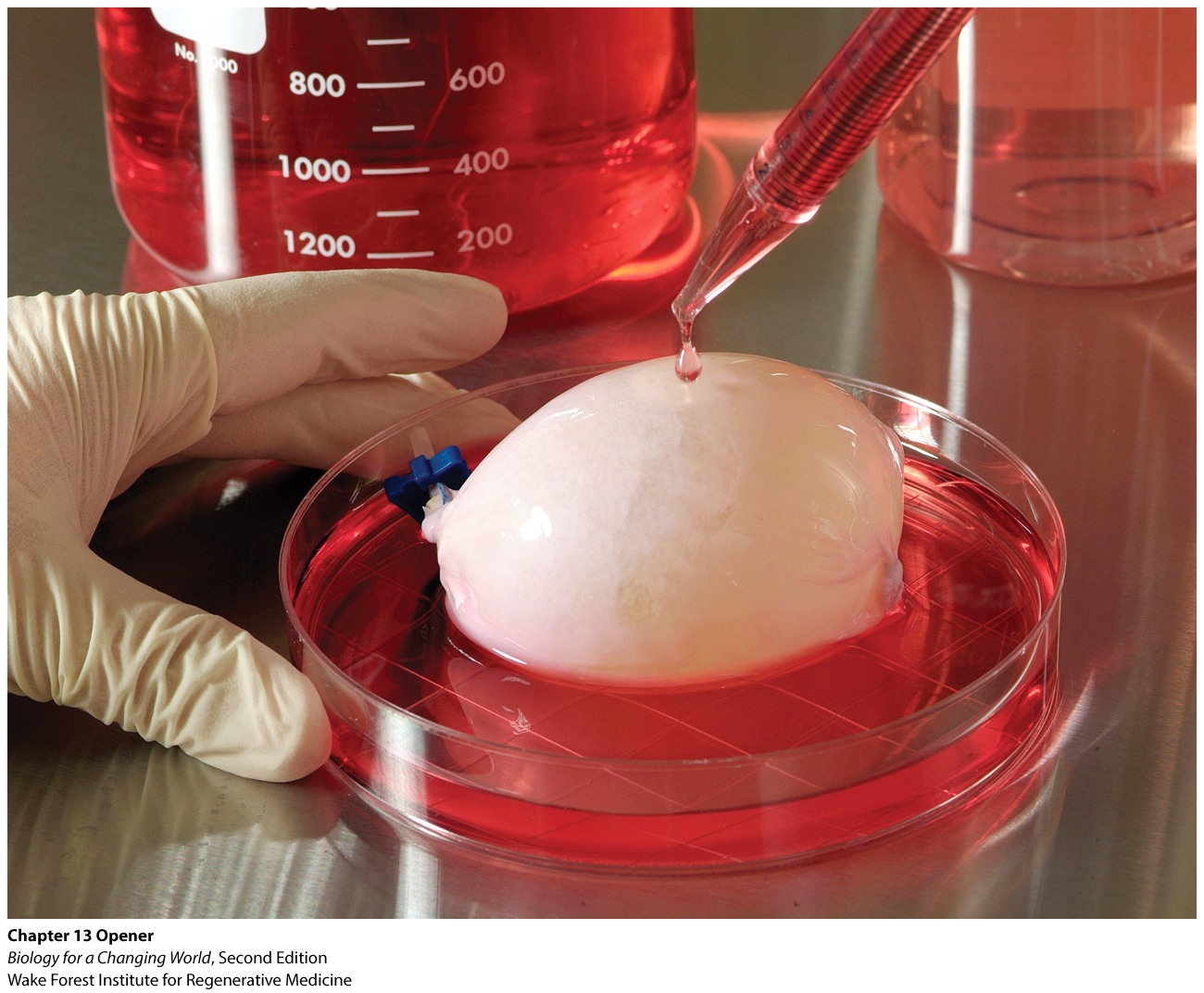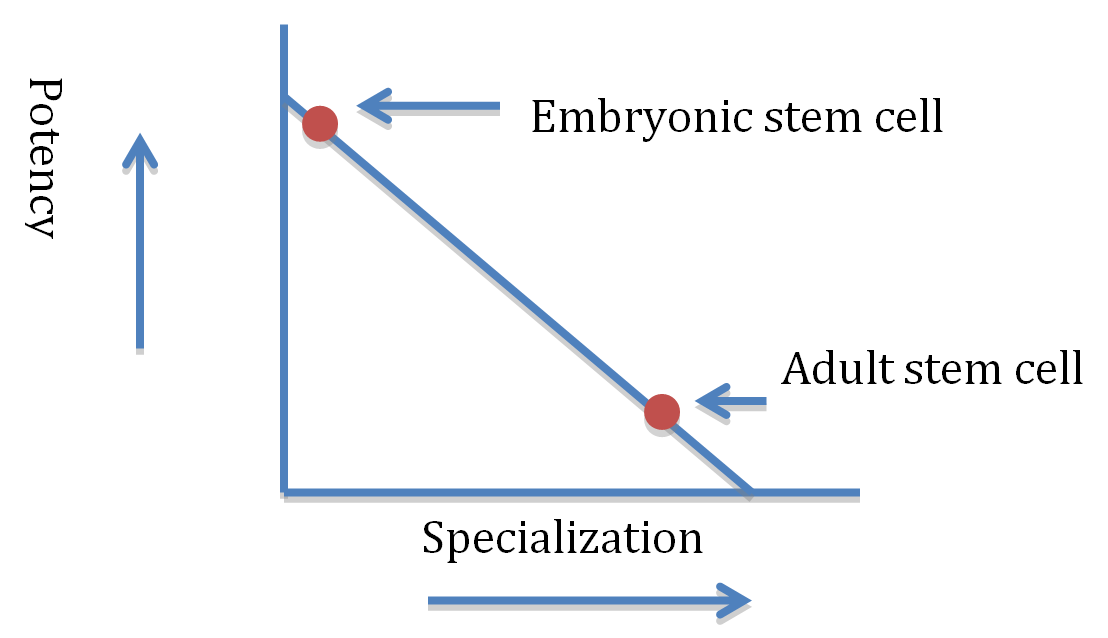Chapter 1. Chapter 13: Stem Cells and Cell Differentiation
1.1 Introduction


Welcome to the Interactive Study Guide for Chapter 13: Stem Cells and Cell Differentiation! This Study Guide will help you master your understanding of the chapter's Driving Questions, using interactive Infographics and activities, as well as targeted assessment questions. Click "Next" to get started, or select a Driving Question from the drop-down menu to the right.
Grow Your Own:
Stem cells could be the key to engineering organs
DRIVING QUESTIONS
- What is the structure of tissues and organs and how can organs be repaired or replaced?
- What are the properties of specialized cells in tissues and how do stem cells differentiate into these specialized cells?
- How do stem cells contribute to regenerative medicine and how can we obtain or produce stem cells for this purpose?
1.2 Driving Question 1
Driving Question 1
What is the structure of tissues and organs, and how can organs be repaired or replaced?
Why should you care?
If we could engineer tissues and organs from an individual’s own cells, we could routinely perform tissue grafts and organ transplants without the problems that arise from tissue rejection and lack of donors. Reaching that goal will be difficult because of the complex hierarchical structure of tissues and organs. Engineering a single, simple tissue is challenging; engineering an entire organ, composed of multiple tissues organized in very specific ways, is even more so.
The idea of using engineered tissues to treat disease and to generate organs for transplantation depends upon the unique ability of stem cells to regenerate cells and tissues worn out with age or damaged by disease and injury.
Cell therapy and the use of therapeutic drugs to stimulate specific stem cells in the bodyare two types of regenerative medicine which researchers hope will lead to new treatments for degenerative diseases (Parkinson’s, for example) and autoimmune diseases (such as diabetes) that effect countless individuals around the world.
What should you know?
To fully answer this Driving Question, you should be able to:
- Describe the importance of stem cells for maintaining healthy tissues.
- Describe the hierarchical organization of cells, tissues, organs, and organ systems.
- Explain the goal of regenerative medicine and the role of stem cells in meeting this goal.
- Compare and contrast the use of stem cells, drugs and biodegradable scaffolding for regenerative therapies.
Infographic Focus
The infographics most pertinent to the Driving Question are 13.1, 13.2, 13.3, 13.5, 13.6 and Table 13.1.
Question Test Your Vocabulary
Choose the correct term for each of the following definitions:
| Term | Definition |
|---|---|
| 7xY4wr/P/9tDpPuuq/QehKNE1EgzFdVuKEC1lcvgqkoflhcyROVr9vRgDB6EfaK89FJLOQ== | An organized group of different cell types that work together to carry out a particular function. |
| tF8wGWQuX7uduIpkQtQLFy4g0XTSuKS15BymLW9LFneCeVzQtaEKdFMC4kJOWDsM3Ud4Wg== | Stem cells located in tissues that help maintain and regenerate those tissues. |
| oo1PqP3DhyEWQ+XS4IuigHmU/3Fikitq9czIARbP+GabNK0Zr4OHP62vSqZl6AB+q5nQcg== | An organized group of different cell types that work together to carry out a particular function. |
Describe the importance of stem cells for maintaining healthy tissues.
Question 1.1
yE9i+i/VFkW8GQN/Qh0xd4eBU0wPxueMw08lpSscGjE=Question 1.2
qJvEd2287Kyu7vGzhOeEhhyjYS+08u8crXsiZyKeR8VXG8U562Pm+YRCq/FP9acqbg9YnID8S6TR+JYNPX/a+w==Question 1.3
ernbz6vr3XFxOJ6tcf7Ih/LUIVudIY3UGcdIq/GJ0wI5EWepGvFzud4aBvH6WtX2PehkfQ==Describe the hierarchy of cells, tissues, organs, and organ systems.
Question 1.4
WSFQzRAHeIM1hwGv5tBIqDwWtVZTnI9DDRcjmVconm7ztyZyNho8M4gQW8oXaLIRnSZ6dfXWqoh6E+ZP2Aq4CFrf/ydQL/uWugW2Lpg2WIU=Explain the goal of regenerative medicine and the role of stem cells in meeting this goal.
Question 1.5
TXERlrBMIbuo2AetwjWlI4AnSOQ4IyOzmefsVIe2v6Yz1MuAohG0WjjItCXtgO1iQuestion 1.6
vXFYYqqgko13cu94iWFJWzR3lITIAgSFPfA620D18jCxbsbY5SJ2olOAsxuNIi3DCompare and contrast the use of stem cells, drugs, and biodegradable scaffolding for regenerative therapies.
Question 1.7
++5Y087uQWo3cjrL7LMV5eeWHGD6uSSz85GSTZcCS5ba53CsOq5puUmcxpZYJNiu++Nq8r2U3aEvrTYIjvwFQwrN6oWu4T5McGi8mUC94RIsKt2KdMahQ1cnWBS90+5r0nBtDkRdwxfDy4mFMV9lQ9Tb4INn/bgXkjmYQimCg5r5umoGg+HGy3NtdufVK4VAIQAGDI1lGOfoBJa56mkMywuHU6KL99tZqI8szrbxpt0=Question 1.8
RB6RrQ8lzTxDJ4UunVRlVjXHNNa2IRzXJ51VYfNQls54gI2J+rIzE1gdyNAL2HcMtWW9CHQtiXVfyyEsCs9bV/q9yNQ+QvBlkucbUMdpwBIx+rPS6Yp3qNNM3v6+eAgkwubAYJmTwuPXbJlWx/R6O5K+npP8kQSYETEao+p1kfiODaikJq3iwA==Question 1.9
UIDyp+jGD2mqOnRcPbqQWJhK12YuC1JEm8DAWyRwCui7y13mvlnYGEwbFT3qGy8vE8b3Tbd/Cv1C10IlF/pAdI7/lnxIrSUnRQnWjWRhcsRF/H54xrAqxbo7NkVwcXtLWDZIiaUvfAw85ek8ZroHL96peQt8VisOUueBimWptqBRtNKhHk6ZwVPYWReBLH7fInMmubw/OfO+GKWYrCTIwl4VcO8lubVVg+HhFirHww4l0OwUN7ykDOVOqoUQdj27Or6qKvSi3x0=Review Questions
Question 1.10
7T3iDSkzG9NNvpmPKSNlClvGXQTLwqAqpASNSmmPmU2G73Y1GvkoHUNw3nhJUokI8P7am/u22iQuuzU50t4Zy8GKUXpCo4OkRpuhORKcNnL32Y8781el6TwwFSoc0U3JE2HFK/YrlfSlnHRkIDh+uo7KpiNi1wibJyZIRNyPSfynRHmjE4bOubBFuXSiHgTSsTYV1Q5nBkMoqwPY5UBHNhSSYvcMc6agdc/API1TABRiq/7JgeXS6GG595drb2D5OwfFoTiBaTthaGISQgNQ4+PcbmKwieDLhNE+RBjQqe2RlsnL0Uhyu5Gj2e6Kbg7zkINL0atcuYbQSDTJtjZfUk3zLEkUprLLmSTH+f+uCnEFR+Bf1e7/nR/kmtyxOa9/OvbhU/TWmA7nvtMno8jsxbuO4/qiFbCrpSHIlUkJuckGZd3Reggii0bZITfa+9LJSQXg2NcLFfxDfBYI0fhjrrJExGQ9d+w8pJycjO+9tFNqzk2Czcm6FvKK7MOYIcKeNtjjCJpA/m1KtzRSis/NB5pW3nbWu6vP9ij6aKb9lOBCAFTn5veAICI3Qi37XlbSnCUdLWr06W0D24MMrczB1A==Question 1.11
9upmccGHvInPS7dWZjmr6E80eTwuyCQFsbawx/mrSL13gdqEDgczHRgC2lquy0hhS1cwrjMON/zAmjQ2SlwNxl23ncUaGRG2ycQXw+sb/f8aobCkMbgnZYgj1n+7ABMYb1fALClDHxzlE/3wTJnAupeNy5tV7exguAMHmAMD48qrZ1qEVI8sBRADP3PmkJBskivsovwB0weqvX6ykUJhfmMWAbXh+4SLKAXNR/4E2Uhetuhn9jNvO+OiyfZvhT6exNVFomJtwEqEH05vjCJViDQHu1wKWcKt3B+Js+aC4Z2YOZtWrpY9u+MNb2rNgcOdTr9x9otq3VavN2l9lEuigOdw9kr7p1s+gUIXaeJUnnbQh9yS8ctErVpFgOpUKzOw5z9xqpoJ8UjycrLomN2+oM/hZXI+rD7Hhkh7NuNn3jszawVeKz4JxirVb87E10FTKDt2GOtJZJSipIbqBNOcjtVVHFUAq7+5Xy/Csj3MHJ3R/LSp1QaM392Uvm3tH17YxHb2+72a3KREoJXmCqkeSiyxjVrLzmMv9Ugt/4kOitKLE1LW9VOFFR9AYR4nnnzMtUdikDhwuX0UKSRkyVL4umyfMriMbsZNPnH9/ALgqMCvgOzzhR8HYfNGt2p+GyV++GFK7CDNyKqdnKiJMw4+8kQpoFIwWo4IJsK14PyEYS6StH5HqpIYxGzmKmQMoFDp6dGRgx11LsysRvB/ead0u6czrGk+Y3ftTfGyrUlsbOZnTSUYR3z+L0IOJfpYP8FWP01KoKuk3Nnzr3TMFed4giUuLlexFd5ZEjnS7nDdDXkIcg1g8Tkoq1tamFd9nYwyVOSYJcydYHetlQwPLn3mzAxosUOsdA1/ZZnKChDUT4vx51/L+wVrmVLixgg6T22qXVca+7CJwU7ugzlcAAKt/uTxQZCWKi4c96DxtWQ32ws2frheCkxc3wt+UI6Px7kxUcjS1QcVAhKSnUmLQuestion 1.12
9pkemFtKpiQUJRMfF57AmMCuZxj1VLJRcvx2lCxvjj+SwQl/49YQDIjyLQw+w50xjZ46st+D2dVMG4jHp1cGqakvYQXmWUHGh8Q3kQsW/LhI/eEjnMTU0vuDy7fhdugStTzDAfCitWgki4IWQLmvKt7PD6KDml6/0YXY3xsKBgwNqLrn1.3 Driving Question 2
Driving Question 2
What are the properties of specialized cells in tissues, and how do stem cells differentiate into these specialized cells?
Why should you care?
Our bodies are made of many different types of highly specialized cells with unique functions corresponding to the tissues and organs they belong to. Although all cells share the same genome, a specialized cell cannot “change” to become a different type of specialized cell. This limitation is why stem cells, rather than somatic cells, are the key to both tissue engineering and regenerative medicine.
What should you know?
To fully answer this Driving Question, you should be able to:
- Explain how two stem cells with identical genomes can become specialized cells with very different functions.
Infographic Focus
The infographic most pertinent to the Driving Question is 13.4.
Question Test Your Vocabulary
Choose the correct term for each of the following definitions:
| Term | Definition |
|---|---|
| WFV0a/tN+GLXuoykbLdtZbfz6a3FsyJKrUDQqVSANF/g2lB8cDaq2pF5fiTIWlGRGYgcJ+KHrpHAtwCr | The process by which genes are “turned on”, or expressed, in different cell types. |
| NhwCvgFTZQfzjm+Sb2WrSX+xtDToAvm5UUzAKsjfzt18Nlw/pVjuIBTnSb9RK+nz7t7jDK8+T0L/CQJV | The process by which a cell specializes to carry out a specific role. |
Explain how two stem cells with identical genomes can become specialized cells with very different functions.
Question 1.13
Two bone marrow stem cells in your body divide to produce two white blood cells and two red blood cells respectively. These cells differ in structure and in function.
Zakgb8lBhuhlgUTMWnpV1mIqE3TngqOTyQsaueDIrrQegvjiB0vKVH8HgogPJWNsW7p30xvfPf49Zjaa/rXlTeLOXKs=Question 1.14
5R02d+BuDH4yGEqfblRjKBAzkgvKyMW5G7diuytpwsVOP+fIel2dlTzdZSInhg3Co1gZgktHBC5nD0JG5AvgAkPsTl7WZD9RQuestion 1.15
ABrhYMaCGuStOtxvLcwKPhIdoorcb0OsTU7IsIPouahOv1ZBcm4GOHLmNfOP4Vq1QzsSlMJfsGb6BkFp/RoYdGVHkV9Qphm1+GhfJKLn1YO3cUkTWhLAkFEkP7xKmnkBqKdDs6at8lxeoGrQx4i9h34eubFa7RXTpsd9driBn3Yk/1dlThought Question: What would happen if every cell in your body expressed its entire genome instead of selectively expressing only the genes needed for its function?
Review Questions
Question 1.16
ajiZWafpCGPp2ISdwL3+XS7sgcUET5cUkANr5/xbXQCPM9firkaegmiwrlzrQBXIDT1eBkklMcLKtP4z4d7joL5YDtjfQM4HT1UHcMo6VN5zC4t9vaOLlcauLYFbJ1w2x7nsK+6rMGUkxBmBoOfi4AJD+YbWzf+kjLdx2uKUwX3vr1opbyPiMJ/f4WillMw3UhNTzw==Question 1.17
U4H7cahjoQc6x7jDxgn1A0Z4IbKJX70WSwYKjxV8zFc0vR6oxOMzYnXzl3VeAypU4q+p9VxkKEhm0TdjSOUNmTR7+rlRe5X91pXLJ36pZtnOfsnrfh/B7TmHZDL2U/QSb6ACN8cJNrqCUDsqJ9k7h7UgavGbS+iWfk6rjG9aCKMNGGH5KZDIwR8dpiHi2hJXCOz4rFyRcnxrNDmWCRDzRS4X/9Q4t6UbuPlvdBmVZRs422LJDnnp2Uv+VNAAZYhXKe5b9gS9yGSvZHqsabkwhAccSbz+nR1GGArue6dMSuEKDpr21r+RArLAnXq/9Np/Cp6Q2yt316EoMQlL1yWszpJaRs8Cd5GWEcJoqqG8kkImeaZPM1REjU4QgzkUzqb11.4 Driving Question 3
Driving Question 3
How do stem cells contribute to regenerative medicine, and how can we obtain or produce stem cells for this purpose?
Why should you care?
The most significant controversy surrounding the use of stem cells in research and medicine is whether or not embryonic stem cells should be used or if, instead, we should limit research and medicine to the use of adult (somatic) stem cells. A clear understanding of the similarities and differences between these two types of stem cells is critical if we are each to make informed judgments about this issue.
A second point of contention is how the embryonic stem cells are obtained. One extremely controversial method is obtaining the cells from the human embryos discarded by fertility clinics. Another slightly less controversial method is called Somatic Cell Nuclear Transfer (SCNT), or more commonly termed, cell cloning. The problem with this method lies in the prospect of it being used for things other than therapeutic treatments, namely, reproductive cloning.
To avoid controversy and regulations surrounding the use of embryonic stem cells in research, scientists have been working on ways to generate cells with the pluripotency of embryonic stem cells without having to destroy embryos in the process. Induced pluripotent stem cells are a recent and potential solution to this very complex and delicate issue.
What should you know?
To fully answer this Driving Question, you should be able to:
- Describe where embryonic and adult (somatic) stem cells are found.
- Compare and contrast the differentiation potential of adult and embryonic stem cells.
- Explain why embryonic stem cells may have greater therapeutic potential than adult stem cells.
- Explain why the use of embryonic stem cells is controversial.
- Outline the process of somatic cell nuclear transplantation and describe the two potential outcomes of the process.
- Describe the process of creating induced stem cells.
- Discuss the significance of induced pluripotent stem cells from both scientific and ethical standpoints.
Infographic Focus
The infographics most pertinent to the Driving Question are 13.3, 13.5, 13.6, 13.7 and 13.8.
Question Test Your Vocabulary
Choose the correct term for each of the following definitions:
| Term | Definition |
|---|---|
| aQ3iPaAF631HzoSZNBVS3UIT4qvjdZl9GOya6sqa9TLlpi1ark0aUs+9LXd2kMULZN5LRW15nO02hgbzziNjcA4RBPwHHcKK7/9AaV8+4WZz3+wcSbg58LSe9wIr4s5Di/oA7GkZTi2Ap5z8xsZdNVR2g1UQqEGyV+1mnJTHGLqfM1i7 | Stem cells located in tissues that help maintain and regenerate those tissues. |
| p9hx7yIojl6S4RE9XkUImCbtvzUjTVt/u0P1dYonHIzTfllt83W7B9OvZ4igVyENU7Wi+juoNCG1mGXNWlrEXKWJk/24dLkaDZThrKg36xVSw3AhkpDHMAtGxBxy0bDtbYfiMRWYkWBctMqT1MfK72T+GGTyHtwO/3gBdNffygDvISeZ | The stage of embryonic development in which the embryo is a hollow ball of cells. Researchers can derive embryonic stem cell lines during the blastocyst stage. |
| 5Y1zF0Agd/TowmtVGCWH1bXGOcL/pbap6BvjEleuFP/ibl8vqHO5liTUN+1zkLOnH/EwP07Ve7uoKj6w5Kim0Y7iHoAMhGpBj6Fz1FAkovlWuovTx/j4BV9Mt9VXzyzpaUE4tihIC8+3+selZQ+M5bAaQYm64UD1Kb83bdlwmIjsu1Ny | Stem cells that make up an early embryo and which can differentiate into nearly every cell type in the body. |
| 4wYfL2ZvUeNdhALiGt8qK5FV3eVgRtvSUuLIkyJrWWpefDHNjt8kQQb6B1WuUaRr0ayMLKRlWH1Q/RD+l3A6rKCFRuRKpiM4hK33rsWp1JMsvh7N7OyCJY+A6UQ4R2RgRjvgURZXpIoXJD34tobCT7iJHrGd1sr88/boF6VEp1496GCc | Describes a cell with the ability to differentiate into any cell type in the body. |
| WefebN9bKqQ3OvuOI8heuZHkoBTNXyhoKCPZY95RyunpjcvNbDw2rMILqSQGcL7mg0N2zM/fG0ZXcz8uci8L+XNhSg/HWrsrfjA3lxf60ZQfJ41Lc8xF94L3L58q8Ctpc+qL8eow6JDgk3/SquLo8PdEtfQupo7meeMK+qxo+lGKgHEU | Describes a cell with the ability to differentiate into a limited number of cell types in the body. |
| Zkyuv8F20TjsHdRYHFiPYNc//GPqmN+DkKMNA6kwnqm4pVBl4cNo/WMGAe9fxM6bVkXZJX9DQTws6KLmfH1NzGnAIcy/e2tPsm8Ea+EviKPT3u1RB/mv1IIZlb1zO8M1/RLjhs6ldBwJ38hweq7ATF4KcnL96XwIJNw4FnrDangutVZf | A pluripotent stem cell that was generated by manipulation of a differentiated somatic cell. |
| Z5xRTRw3cCEcc2lWK9CNLdIVyhntcUOIsxnttjSpYxB+ENYZgBIsuxksLSGixRsB1O/mOfWL7msF/vH9s6ouDViqa8Mtz35WPAkcuf20tHz6WBYrxAigqtiDq4BTxq5xkuybF0gpt1mp/AcQ6HVTgyOrUgrF3MnfZjUTrNMRHkAyR0DR | Describes a cell with the ability to differentiate into nearly any cell type in the body. |
Describe where embryonic and adult (somatic) stem cells are found.
Question 1.18
IppW9Tr7BJe4vPsf+U48bSdQC0mmQVNcJCprptjPqcg8n6wRCilzMu1zq4HwL6WWgjFzJjWhhL+flHvEfdN9JA7Fa/IGGlQv/xLW8ApM6VxPJLUaDPnMJVAWs/0/0K1+yJlbmg==Compare and contrast the differentiation potential of adult and embryonic stem cells.
Question 1.19
rJh/trctdMUsAsg3PSdYRfc0iUziAiLPovxC3G28x8kHuj8/tsPW6UTEJ03fIVbFlP3T2j7xdXYxfyF1TiNU2DWZvNXNWmCnxJmxQmi+MBup1wUT57ppnXkvOLi5qaYqKAvbFoXmVBCcuFgYkrw/Yu3Baz8ocPeWsvuv6g==Question 1.20
8wLkellQY7tfRFdO36YDXVO4nihPyDJ7WbMcZCx3V6uQenK8/S+iW0jaUBPsHmdEv7UZ3fsloFsaIeCJI+j95AhUyMmOBXl5+Q0F7Q8NeIBQFOd9Q5ykgTw/etD6Go/UOxlhDtAGO6XZMxGIMguXb2OA6oTm27LLb46QGXpaso4=Question 1.21


As stem cells become more specialized, they lose their potency.
Explain why embryonic stem cells may have greater therapeutic potential than adult stem cells.
Question 1.22
bgP64luDiepItDkNiS3DnjOE0eRNta3kN0O+V5lEay83NW+pQ2gB4plNX2aow3Iom4hUlqdB/jqvTeYgjEyv1WN+DuX7wW1+n0KEdfpsRkioSjE0aH/LyCDfbMW10jQkUTWJJPbhAj7zZIo4dVlOtD3Q+g8=Explain why the use of embryonic stem cells is controversial.
Question 1.23
C2ulX7m4ehhHUWJRHN808+b0+UpIr1N1VmC0lQUjog5pHa8CZ6pINcwL6OvefffrV8E1QLX+0F3EY2u/R3WKemGKeYChNgNp/0h4CBScUVrttR9ipkHFiXCm1YtOuG2TbssOCb+d7eEwD0N6U64aldgnhmmWAF1bq4S14SSWsOY=Outline somatic cell nuclear transplantation (SCNT) and describe the two possible outcomes of the process.
Question 1.24

1. Remove the nucleus from an egg cell.
2. Insert the nucleus of a somatic cell from a different individual.
3. The egg cell, with donor nucleus, divides and becomes an early embryo.
4. The embryo develops into the blastocyst stage.
a. The inner cell mass of the blastocyst can be removed for stem cell culture.
b. The blastocyst can be implanted in a surrogate mother to develop into a fetus.
Question 1.25
5TN3dufuAKms8IeCGGoPdT8DGXYmODSURTUnDQnW0C+EUsxjgIBfeMI32dgm9sMbb7VZEV6pwjprQHu8PhtzoQt/ow0=Question 1.26
ACQyIZckH586nPe2rvuBZv6kPD2yrbbQkXIjgqsgsx/BZikqyYiAtPv8ekrwPmgEypFCWsqXr7k8fjNm45vCEOFbHwj9QDoWNwj9Fh7Ydjgki+/LZPjgOiZ10zIeiQyex+LLFA==Question 1.27
/rHSP39y60frcuoEf3SbsCCuzhoX8h6tfAPqdNcij7d9PxfTs8J6vJVp59Knmbd5CtrAGDL930Y=Thought Question: What would happen if the tissue donor nucleus came from a sperm cell?
Describe induction of stem cells.
Question 1.28
Kc3vKWkLfhtl/Sqh8AYnrkarCEa+TGZk/bBF7vZOYDRtrR9SKMxq65HK5aPVIVjTzL+ARkVzvef9dWxkdyaryq+Uf2xnyuaIwdZaKOkq7pSPry2OV/x7VDS7LIjCLxXYnHnr0A==Question 1.29
fHkXjijeP3ambTUJAF24/YXcfxDkB2nMBcInuD3efiEZn+RttTJ4cQKwdwteKRL+XAq0VyMcqMmuHgBFBO26GQSwRK+SqFRRyF5oqH8UnUZd45j6ZWykK7PpsalN17jvz/jyxA==Discuss the significance of induced pluripotent stem cells from both scientific and ethical standpoints.
Question 1.30
tNSpC0OTsPgnnTVh0NybBj0x85/KHXf0L0HI4LzfvPcb0bn9gtBM6P1FO6ZMTr+ao7C3U8YBjvUFIdoTjwGc/qcMC/Lw+AozuuyelySdGyuuoy3vJzx3Ay+kys8=Question 1.31
EtOVREEkBmGxCV+JuuWEiobDKsNOscXtaJla65JZgkP4DEkh9bYIHYp6diIgx7U/APlYL1LbLSbD7KFO9g21Bo8yLwcvQ1biVMgC3BJOoaUej5JIoT2Mbh1+Z8ah+jO14CXhnXf1D3gxAavpxO7YQcLexi1USsFAQLU2XroCVBLRmD1w0pjDsp4cVJ3ewOeZxcnFDA==Review Questions